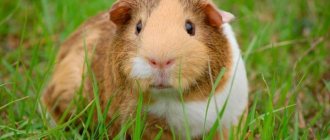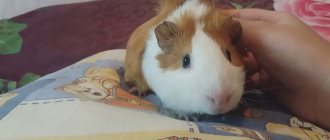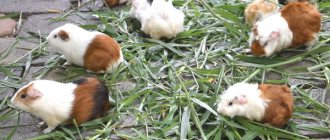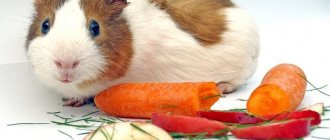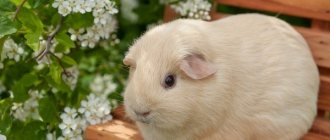The guinea pig squeaks, purrs, whistles, growls and, in general, is musical and talkative. Everything that people explain in words, the animal expresses in various sounds and movements. According to the observations of experts, the language of a rodent is very diverse and includes more than a dozen different sounds. Each sound signal has its own meaning, so it’s quite possible to understand what your pet wants to say. To learn your pet's language, you only need observation. A little time - and the animal can be understood at a glance, or rather, at a half-sound.
Sniffles/wheezes/whistles
A satisfied pet often sniffles, and a well-fed pet whistles.
While waiting for a treat, the animal may begin to sniffle and gradually switch to whistling. This situation can occur when opening the refrigerator. Ah-ah-ah! They didn’t give me a treat!!!
If the owner does not get a treat, the pet can also whistle to attract attention to his person and get something tasty. A prolonged whistle or a whistle repeated after a few seconds by animals can serve as a greeting or signal that they are hungry
A prolonged whistle or a whistle repeated after a few seconds by animals can serve as a greeting or signal that they are hungry.
If your guinea pig wheezes when he breathes, he needs to be seen by a veterinarian.
Guinea pigs are interesting creatures. They “know how” to talk! At first glance, it seems as if these are completely unsociable, quiet animals: they sit in their cage and constantly chew something. In fact, a guinea pig living in a house whistles, squeaks, purrs - in a word, communicates in every possible way with its owner and its own kind, if it does not live alone in a cage. To better understand your pet, you need to learn the basic “words” of his “language”. Let's figure out why guinea pigs squeak or whistle, growl or chirp like birds - what does it all mean?
The “language” of rodents is quite diverse. Animals:
- squeak;
- they whistle long;
- they squeal pitifully;
- cooing from the womb.
It is necessary to distinguish between when they “talk” to each other and when they require attention from the owner.
A guinea pig whistles when he is bored or lonely. For example, if a pair of rodents lived together for a long time, and then one of the neighbors was evicted, then the second one tells the world about his loneliness and sadness. After all, without a comrade, he feels anxiety, melancholy and even fear.
Does your guinea pig whistle at night? Perhaps she is waiting to be spoken to. Do not forget that these rodents have a different rhythm of life than humans: for the most part they sleep during the daytime, and are quite active at night. Perhaps the guinea pig has run out of food, it wants to play, but the owner is resting carefree in his bed and cannot be woken up. So the animal is forced to make loud, not always very pleasant (especially at night) sounds.
Why does my guinea pig constantly whistle? She is probably spoiled by attention and loves to beg for tidbits. Sometimes animals sort things out among themselves
In these cases, they figure out “who’s boss” and use other sounds. They may purr loudly and intermittently while standing in a tense position. Or click their teeth and make hissing sounds. In this way they warn the opponent: move away, I will attack now. Don't encroach on my territory and my food!
Sometimes animals sort things out among themselves. In these cases, they figure out “who’s boss” and use other sounds. They may purr loudly and intermittently while standing in a tense position. Or click their teeth and make hissing sounds. In this way they warn the opponent: move away, I will attack now. Don't encroach on my territory and my food!
Why does a guinea pig whistle, and then his whistling turns into chirping, similar to the singing of birds? The reasons are different, but often they mean excitement, possibly fear, stress.
It happens like this: guinea pigs stopped whistling when they were placed in the same cage. If they have a good appetite, are active and cheerful, then they simply “found each other.” Just don’t put a male and a female together! Pairs must be same-sex, otherwise the female will constantly bear offspring, and her vitality will not last long.
Another sound of communication is uterine grumbling. Guinea pigs, when they feel good, when they are full and satisfied, can lie flat on the floor and purr measuredly. This is a great sign, but only when the rumbling is even. Restlessness, combined with nervous movements, indicates that the animal is afraid of something, it doesn’t like something.
When do they communicate?
Pigs convey all their feelings through sounds. But let's look specifically at each of them.
If a guinea pig squeaks a lot when you come in, this may indicate that it misses you and is simply happy to see you, or is waiting for another treat from its owner. The guinea pig also squeaks when you pet it. Animals can squeak if they want to eat, especially when the kids wake up and demand breakfast. Pets can “beg” like this. That is, they are not very hungry, they are just hoping to beg you for some tasty treat. Try to follow such tricks infrequently, because pets may become obese in the near future. A guinea pig's whistle can indicate pleasure from a tasty meal. The male may squeak to attract females. Toddlers can make similar sounds to indicate that they are scared. Therefore, when the female has given birth, it is better to keep the babies near her so that they feel warm and protected. When scared, little pigs may hide in a corner. Perhaps if your guinea pig squeaks, it means he is not feeling well. During constipation, you may hear a plaintive squeal, so watch the food your pet eats.
Always remember that any sounds your pet makes indicate requests, these are attempts to attract attention. Keep an eye on them and you will soon begin to understand your pet.
Why does a guinea pig whistle when communicating with a person?
If you come home and see this picture: the pig has risen on its hind legs, looks at you and whistles, this means its joy and impatience: the owner has come, he will soon give you something tasty. The pig expresses his desire for a snack especially loudly when he sees that the owner is reaching for food.
Sometimes by nightfall the animals manage to eat the evening portion of food and call the owner with a squeak, demanding that he add more food. How to stop a guinea pig from whistling, making loud and disturbing sounds at night? Try pouring more food and don’t forget to add tidbits that the animal especially likes. It will be carried away by absorbing food and will not bother you.
Sometimes a loud, desperate squeak indicates that the animal is feeling unwell. Listen: the sounds are sharp, stop only when you inhale, is the pig restless? It urgently needs to be shown to a veterinarian: this is how rodents demonstrate that something hurts them.
If a pig is spoiled, it often squeaks dissatisfiedly in order to arouse pity from the owner and demand a treat.
Be sure to pay attention to the behavior of the animal, just in case, check it with a veterinarian
It is difficult to understand at once all the signals with which a guinea pig “talks” to you. Patience and observation will be required. If you learn to understand the “words” addressed to you, your pet will feel that its needs are being met. He will feel comfortable and warm in your home. Then he will live happily ever after, delighting you with a good appetite and cheerful mood.
Play with the animal, feed it plenty, but don’t overfeed it, take care of the cage, talk to it, call it by name - and the pig will practically become a member of your family. In the evenings, she will greet you with a joyful whistle, and after having a snack, she will purr on her lap like a cat. Learn her language to better understand each other!
Guinea pigs are amazing animals; they are easy to care for, but can bring a lot of positive emotions to their owner. When thinking about purchasing a rodent, you need to take care of everything necessary for its maintenance, as well as study some behavioral features. What is needed to keep guinea pigs at home?
Mating process in red-eared turtles
This is a freshwater animal. Red-eared turtles live in nature in dirty, swampy reservoirs and ponds. Moreover, males are smaller than females.
There are two answers to the question at what age red-eared turtles mate. Readiness for the mating season of individuals of both sexes in nature is achieved by six years. But at home, females mature at five years old. Males become sexually mature by their fourth birthday.
Reproduction under natural conditions lasts throughout the spring, starting at the end of February. Directly in the water, the “groom” places himself in front of the “bride’s” head, and they swim in parallel. Only he periodically makes a backward movement, touching the chin of the individual he likes with his claws. To lay eggs, the female chooses dry land, where she digs a nest.
How do red-eared turtles mate in captivity? They also do this in the water.
For the breeding process you need to have several females. They only need one male. During marriage, the future daddy becomes very active. With his shell he touches the back of the selected turtle and tickles it with his paws.
Article on the topic: Can a child be allergic to a turtle, symptoms of allergies to red-eared and land turtles
The chosen one and the hero are placed in a separate vessel. The act lasts for a quarter of an hour. Comfortable water temperature is +25 degrees. It should be poured no higher than 12 centimeters, since the “bride” will need to breathe.
Then both are returned to the common aquarium. After some time, the male begins to court another female, and the process is repeated.
This is how land turtles and red-eared turtles mate.
The main diseases of guinea pigs accompanied by sneezing
Below we list the main diseases of guinea pigs accompanied by sneezing. Some of them do not require veterinary intervention, while in other cases immediate assistance from an experienced specialist is required.
Allergy
One of the most common causes of sneezing is allergies. It can arise for anything. If the owner notices that when using a new litter or food, the pig begins to sneeze and itch furiously, there is a high probability that this is the case.
In such cases, it is recommended to immediately stop using the product that caused the reaction. In many situations, the hallmark of an allergic reaction is conjunctivitis (the animal's eyes become watery and red).
Cold
It is known that vitamin C is not produced in the body of guinea pigs and humans. That’s why colds occur quite often in these pets. If a pet begins to sneeze after hypothermia or a sharp change in room temperature, this is almost certainly caused by the activation of pathogenic and conditionally pathogenic microflora. Often colds are accompanied not only by sneezing, but also by coughing and rhinitis.
Respiratory tract damage
Another cause of sneezing is damage to the respiratory tract. The pathogenic agent in this case is often caustic and irritating substances.
If the pig is allowed to run around the house from time to time, you need to make sure that he cannot get to household chemicals or anything like that. If there is a suspicion that this has already happened, the mumps should be taken to the clinic immediately!
Entry of a foreign object into the respiratory tract
An even less harmless cause of sneezing is the entry of a foreign object into the respiratory tract. Often everything is quite harmless: a piece of food or filler gets into the pig’s nose, after which the animal sneezes “with feeling.”
Most often, this is enough for everything unnecessary to fly out of the respiratory tract. But if the “beast” begins not only to sneeze, but also to choke, you must immediately call a veterinarian. Most likely, in this case, the foreign body turned out to be quite large and completely blocked the lumen of the respiratory tract.
Care of masonry and newborns
Red-eared turtles lay their eggs in sand or soil . It is better not to leave the clutch unattended: leaving everything as is, it is more difficult to control development and increases the risk of losing all the eggs. They may be accidentally damaged by the turtles themselves, or mold may develop on the eggs.
It is best to transfer the eggs to an incubator . This must be done extremely carefully, trying not only not to damage, but not even to turn them. Some experts advise marking the top surface of the eggs with a marker, which makes it easier to control their position.
The temperature in the incubator is set between 21–30 degrees . Changes are unacceptable, so I did not want to place the incubator in a place that would not allow:
- exposure to direct sunlight
- drafts
Development of the embryo lasts from two months to six months . After the babies hatch, they must be “separated” from the adult turtles. If it is not possible to place them in a separate aquaterrarium, you need to at least fence off a separate area for them inside the main one. In order for the “young animals” to grow and develop normally, it is necessary to periodically allow them to “warm up” under the rays of UV lamps.
The ideal food for newborn red-eared turtles is raw, lean fish. To ensure that the food is balanced, it is worth periodically feeding the babies with special food for newborn turtles.
Why is a guinea pig called a pig?
The guinea pig belongs to the rodent order, the pig family. But they have nothing to do with the pigs we are used to.
There is no exact data on where this name came from, but there are several theories why it was called that:
- External resemblance. Guinea pigs have an elongated body, a dense build, a short neck, short legs, and a large head relative to the body. The limbs of guinea pigs are very similar to hooves, just like those of ordinary pigs. It is because of this external similarity that they were nicknamed pigs.
- Characteristic sounds. The sounds that guinea pigs make are very similar to the sounds that regular pigs make. They squeak, squeal, and grunt. When they see food, Kevi grunt and squeal very demandingly and persistently. If the animal is frightened, it squeaks and squeals. During the mating season, guinea pigs grunt very often. It is for the similarity of the sounds they make that they got their name pigs.
- In ancient times, Indians in Peru kept guinea pigs as livestock. They were specially bred and used as a source of meat. The carcass of a small animal is very similar in appearance to a suckling pig. Today there are only a couple of places left in Peru where you can try the guinea pig dish.
- Another name for this animal is Cavia porcellus. Translated from Latin, it roughly means little pig or guinea pig.
- Another explanation for why guinea pigs are called this is that they replaced the piglets on the ship. Ordinary boars were often taken on sea voyages and used as a source of meat. But they needed to be fed often and a lot, and they also took up quite a lot of space. Kevi were much easier to keep on a ship, so over time they replaced ordinary piglets.
The animals remaining on the ship were brought to Europe, where guinea pigs were a curiosity. Because of this, demand for them rose very quickly, and accordingly the price. It became unprofitable to use them for food, and soon they began to be bred and kept as pets.
What is another name for a guinea pig?
The guinea pig has many other names: Kevi, Cavey, Kui, Guinea pig, Indian pig, Indian rabbit. In different countries this animal is called differently.
In England, the guinea pig is called the Guinea pig. Once upon a time, the British often sailed to the Guinean Islands, where these small animals lived, hence they were called Guinean.
In Great Britain, France, Italy, Portugal it is called the Indian pig, in Spain the Indian rabbit.
A guinea pig is called a guinea pig in just a few countries, in Russia, Poland, and Germany.
Mating games
Turtles are no strangers to demonstrative displays of affection. Males become very active during the mating season. Many people make the mistake of considering turtles to be silent creatures. After all, males, when courting their darlings, often make sounds similar to yapping. And females have the right to express their opinion with their voice.
Article on the topic: How do turtles winter in nature and at home, will they survive in a pond in winter?
Usually males challenge rivals to fights. And during the period of “fighting”, weak animals can be injured and die. So it would be a huge mistake to consider turtles as calm and good-natured animals.
The male is not so loyal to his chosen one either. Seeing a female, it begins to shake its head up and down. But he does not intend to wait for her to reciprocate her feelings. Having performed a ritual dance of recognition, the male runs to the turtle and hits it hard with his head in the shell. In addition, he bites the reptile's paws until it is eventually subdued.
What the sounds of guinea pigs tell us
From the first minutes of the appearance of a guinea pig, your house will be filled with a variety of sounds: whistling, squealing, grumbling, grunting and other sounds that this cute animal makes. All this is an expression of satisfaction, fear, aggression, or a warning to comrades about impending danger.
The sounds you hear from your guinea pig express his mood at the moment. Over time, you will learn to understand your pet well. We will talk about the basic sounds and their interpretation:
The most common sound a guinea pig makes is a sharp whistle, which is repeated at intervals of about a second. This is a signal to greet the owner when the pig is hungry and it is time to feed. The sound is similar to "whip, whip." These same sounds may indicate that your baby is demanding attention.
If your pet whistles softly and squeals gently, it means he is satisfied!
Grunting and sniffing another individual indicates a friendly greeting.
Grunting and rattling, similar to drumming, indicate a greeting to other individuals, and the male thus attracts the attention of the female, and indicates readiness for the mating ritual. It's like he says "brrr"
A higher, shorter "brrr" means your guinea pig is irritated or startled by a loud noise. For example, she can react to a nearby phone ringing or the sound of a TV, loud or unfamiliar voices around.
A high-pitched and loud piercing squeak, similar to a groan, stopping only with inspiration, means that the guinea pig is in pain.
Tapping and clicking teeth indicate that the pig is angry and ready to attack (this happens mainly if two males meet). This sound also indicates that the guinea pig is afraid of another individual or person.
These animals are not only talkative, but also active. You can tell a lot about the state of the animal by their behavior and body movements.
If individuals touch their noses, this means that they are sniffing and greeting each other. Stretching out on the floor signifies comfort and tranquility. Jumping up indicates your pet is in a good mood and is playful. Throwing its head up indicates that the animal is demonstrating strength. If a guinea pig begins to purr and lowers its head, this means that the animal is scared and offers to make peace. The guinea pig's tapping its teeth and creaking indicate aggression, thus it warns its opponent that jokes are bad. Stretching your head forward indicates vigilance. If a guinea pig has its paws tucked in or pressed against a wall, it means that it is helpless and requires protection. The female opens her mouth wide and shows her teeth - thus driving away the annoying male. To distract the enemy's attention, the guinea pig has to freeze in place and pretend to be dead.
The guinea pig is a unique creature. It will never cease to amaze you if you want to know more about this animal. Finally, let’s talk about interesting facts related to guinea pigs:
- It’s impossible to believe looking at this small rodent, but the ancestors of guinea pigs are huge creatures that weighed up to 700 kg.
- Guinea pigs are most active at night. The animal sleeps only about 10 minutes, and they sleep several times a day.
- Don't be alarmed if your guinea pig starts eating its own droppings. With these actions, it compensates for the lack of vitamins B and K in the body. When passing through the intestines again, these vitamins are better absorbed.
- Guinea pigs have the opposite number of chromosomes to humans. A person has 46 of them, and a guinea pig has 64.
- Under unfavorable or stressful conditions, a pregnant female guinea pig can “preserve” the pregnancy for several years or “absorb” the embryos.
- The longest fur of guinea pigs reaches 50 cm. This is a feature of Peruvian rodents.
- Penicillin is deadly to guinea pigs.
- A fall even from a low height can end disastrously for an animal, and can even be fatal.
- In the wild, guinea pigs live in burrows in small groups. Animals communicate with each other using special signals, which we talked about.
- When they appeared in Europe, the animals cost a lot of money and only the nobility could afford such a pet. In England, guinea pigs lived at court and were the favorites of Queen Elizabeth I.
Conditions for mating
Reproduction of the red-eared turtle is possible subject to the optimal age for mating - individuals must be young, but at the same time have reached sexual maturity. The readiness of females to reproduce is observed at the age of five, males begin to give birth to offspring in the fifth year of life. If you keep more than two turtles at the same time, it is advisable that there is only one male among them, otherwise the males will fight for the opportunity to mate, causing injury to each other.
Pond slider
What is necessary?
To ensure decent living conditions for your pet, you need to purchase the following equipment:
A cage. It should be spacious, since this is the animal’s only home. For one pig, its size should be at least 90 x 60 cm. It is advisable to keep guinea pigs in same-sex pairs, since they need communication with their relatives, so the optimal cage size for two animals should be at least 120 x 70 cm. Instead of a cage, you can use a rack or pen on the floor, but they must also be spacious enough and not resemble a punishment cell.
- A house or hammock for the animal to have its own shelter. Pigs are very shy, so they need a place where they feel safe.
- Feeder and drinker, which should be designed specifically for rodents. The feeder should be difficult to knock over, and there should always be fresh water in the drinker.
- Litter. For these purposes, it is prohibited to use cotton wool, paper or newspapers, as they can be very harmful to the animal. A thick layer of sawdust or pressed granules is used in combination with a PVC mat. You cannot use granules exclusively, as they can lead to problems with the animal’s paws.
The list of necessary things should include a carrier, which may be needed when visiting a veterinarian (rodent specialist - ratologist), a comb for long-haired breeds, as well as toys - balls, tunnels. By the way, it is forbidden to use a hamster wheel as a toy, since the pig’s spine is quite weak and is not designed for such loads. For the same reason, it is not recommended to use leashes and harnesses.
Cotton pad pig
You can create a craft in the shape of a pig with your own hands and from very simple materials, for example, cotton pads. This does not require any special skills and even children can cope with this task.
First of all, you need to paint cotton pads with diluted gouache, watercolor or acrylic paints, depending on what you have in the house. Then we cut out the legs of the future pig, ears and snout from one disk. Then we assemble our pig, gluing all the parts in order.
The eyes can be made from beads or colored paper, and the nostrils can be drawn with a black pen. And now the little charming pig is ready. You can use it to decorate a postcard or make an original panel.
Here are just a few interesting and creative ideas that will help you create truly unique things with your own hands and give joy to those for whom they are intended. And when imagination is connected to the creative process, the thing will acquire even greater value.
Moments to be wary
A heart-rending cry means that the animal is afraid or feels pain. And at the moment he feels bad. As soon as you hear something like this, immediately go to your pet to see if everything is okay with him.
You should also pay special attention to teeth grinding. This means that the animal’s teeth begin to grow, but toys and solid food do not help.
If the situation is left unchecked, an infection may occur. And in this case, you should immediately consult a doctor.
A veterinarian tells more about the language of communication between guinea pigs and the outside world in the video below.
A rare sound made by guinea pigs. It really is very similar to the chirping of birds. Not all guinea pigs make this sound. Many owners have never heard it from their pets. But some people have a pig (or even a pair) that makes this sound relatively often.
This chirping can vary in frequency (faster, slower) and volume. It may seem that while chirping the pig is in a trance-like state: some climb onto the house and sing their “song” with their heads held high; some climb into a secluded place (a pipe, a house, huddle in a corner) and look extremely worried. At the same time, the pig sits motionless, not paying attention to anything, with his eyes wide open, looking at one point. Usually, relatives living in the same cage with the songbird or in the same room become quiet and can also sit motionless.
The duration of such “singing” can range from 30 seconds to 20 minutes. When the singing ends, the pig goes about its normal business as if nothing had happened. This behavior and the meaning of this “song” are the subject of much debate. There are different explanations for this behavior.
In the book “Behavioral Differences Between Domestic and Wild Guinea Pigs” (Mammaliology Section, Vol. 52, 1987, pp. 294-307)*, Dr. Adelheid Stanke defines chirping as follows:
“Chirping is one of the loudest sounds in the vocalization repertoire of guinea pigs. Sounds are produced in quick, rhythmic succession. When guinea pigs can be observed doing this activity, in addition to the mouth, the whole body also moves under the influence of the efforts made to reproduce this sound. The chirping can occur for up to 20 minutes, during which a maximum of 100 sounds per minute will be produced. In 20 minutes, 800 sounds were counted.
The chirping has been recorded in two different situations: animals in a state of high arousal and stress following a major conflict. In the first case, the sound was a response to an unfamiliar environment or an unexpected sound. In the second (the most common of a number of cases) during specific social phenomena within the group, such as the establishment of rank or during conflicts (in males), when females were ready to reproduce. The chirping never occurs during skirmishes, but often only after several minutes or hours.”
Norbert Sachser (“Social Physiology: Guinea Pig Studies.”*) describes chirping as a stress signal. He's writing:
“Animals chirp mainly when they are socially overloaded, which does not allow them to cope properly in a certain social situation. Overall, chirping is a very rare occurrence.”
People have offered various reasons and explanations for this unusual behavior. Many guinea pig owners have concluded that chirping often occurs during the estrous period of females and in cases of ambiguous social status of the pig in the group, especially when joining an established flock. Often, skirmishes, conflicts and clarification of social rank are the cause of tweeting. The pig cannot occupy a certain level on the hierarchical ladder, which causes it to be in a state of stress. Also, there is an assumption that they tweet out of loneliness. It has been noted that in the wild this signal is a “warning” to other pigs that danger is nearby.
Conclusion:
Various factors are responsible for the mysterious chirping of guinea pigs. To make approaches to explain this phenomenon and more or less understand your pet, you need to observe him before and during this behavior.
Squeals, whines or moans
The pig can squeal with delight. She so vigorously expresses joy when she was picked up.
The pet must constantly be in the thick of things. If you take him to the back room and don't pay attention to him, he will get bored. When it is not possible to devote time to an animal, it is better to buy him a same-sex pair.
Walking around the room, the animal can easily make friends with other pets. Much will depend on the characters of the pets. If the kitten or puppy is sociable and friendly, they will enjoy the proximity of an affectionate pig.
An animal can squeal loudly not only from delight, but also from pain and fear. When trying to free a stuck paw or when another danger threatens.
What do moan-like sounds mean? This means that the pet is sick. In this state, he whines or groans. He will stop doing this only when he recovers.
How to understand what your pet wants?
A persistent, incessant squeak at intervals of one or two seconds indicates the pet’s obvious hunger. Compassionate - speaks of fear or fear in cubs
Older pigs that are kept alone are trying to attract attention and have some fun. Cooing somewhat reminiscent of the clucking of a hen - the pig is well-fed, happy with life and is in a great mood - for her at this moment the world is beautiful and impeccable
“Grunting” is an expression of friendliness when meeting other relatives. The same sound can mean that the pig is busy with something very exciting. Growling - this basically indicates the pet’s fear of an opponent who is stronger than him. By the way, this opponent can also be a person - that’s why a guinea pig squeaks when you pet it. Having heard a menacing, or rather frightened roar, accompanied by the clicking of teeth, it is better to leave the pet alone before he uses his sharp teeth; The rattling purr indicates mating games - this is how the male attracts the attention of the lady of his heart and courts her. If suddenly the female has no desire to communicate with the opposite sex or she is not ready for mating, then in response she will begin to bare her teeth and growl. A piercing loud sound that you wouldn’t expect to hear from such a small creature, more like a groan, a way of talking about pain. You cannot ignore such a squeak, otherwise you may pay with the life or health of the baby.
Guinea pigs are interesting and even mysterious creatures that give the joy of communication to their owners. By learning to understand and feel furry rodents, you can always achieve perfect harmony in the relationship between pet and person.
Rumbles, purrs or growls
When an animal purrs, it often means a negative attitude towards the situation. This sound is different from purring, which expresses pleasure and approval of what is happening around. If you sit a rodent on your lap and stroke it, it will purr like a cat.
Rumbling can also express pleasure if this sound is combined with body vibration. The pig can express joy vigorously. If it purrs and vibrates, in 99% of cases this means anticipation of a happy moment. For example, when they lay out an enclosure in front of a cage for walking. The animal’s mind is ingrained in the understanding that the enclosure is a pleasant walk, and he will be happy.
If a rodent growls, it does not always mean that it is angry. During the mating season and at the moment of mating, the animal can growl in a low pitch. If you listen closely, such a growl is radically different from the sound that a pet makes when angry.
Negative signals
A frightened guinea pig will say a dull “Urrrr”, similar to a vibrating alert on a phone, and will tremble slightly. But she indicates irritation with a short sharp squeal - for example, when you carelessly touched her. If the pig is angry, it squeals for a longer time, while clicking its teeth, as if warning: “I’m not in the mood for jokes!”
One of the most impressive sounds a pig makes can be heard at night. This is a very sharp intermittent squeak, similar to the cry of a bird caught in a snare. At the same time, the pig freezes in place, her gaze glazes over. An inexperienced owner may be afraid for his pet. This sound is used by pigs to call their relatives. Little pig babies can express their fear this way.
If the pig is hungry, you won't miss it. She will stand up and scream shrilly throughout the apartment: “Wee-wee-wee!”, moving her ears. It’s amazing how loud such a small animal can be! Guinea pigs study their owners. They usually remember sounds, such as the sound of a knife hitting a cutting board when preparing a salad or the rustle of a bag from which cabbage is taken out. Subsequently, upon hearing these sounds, the pigs whistle invitingly. They also have a well-developed sense of smell. So you’re unlikely to be able to quietly snack on a cucumber; the alarm will immediately go off!
Very often the guinea pig makes sounds.
There is nothing strange or surprising about this.
These animals are quite sociable. They show their emotions and mood through sounds. There are several reasons why a guinea pig whistles.
An animal's whistle may indicate that the animal wants to eat or get some tasty treat. This most often happens in the morning. In such cases, pets very often stand on their hind legs
In this way they attract the person's attention and greet him.
Sometimes you can notice a quiet purring. Animals show their pleasure with these sounds. Most often, such purring can be heard after eating.
Guinea pigs whistle
when they want to warn family members or cohabitants about possible danger. Males can also show that they are the main ones in this family. Sometimes this whistle sounds like a loud roar. Most likely the animal is sorting things out. This is absolutely normal.
Quite often it is baby guinea pigs who squeak. This means that kids are afraid of something and are trying to warn others. To ensure that babies squeak less and are not afraid, you should not immediately separate them from their mother. At first, they should get used to it and become more independent. Leaving them with mom will save them some extra stress.
Why does a guinea pig squeak?
It is also possible that your guinea pig is squeaking because it is in pain or discomfort. The squeak in such cases is a cry for help. This way the pig can report its illnesses. For example, with constipation, you can hear a pitiful squeak
Do not forget that with sounds the animal tries to attract the attention of other individuals or humans. Therefore, if you hear a squeak, it is better to approach the animal and understand what it wants to tell you.
A guinea pig's growling may be a sign of fear of another animal. A guinea pig can also growl if you hold it in your arms for a long time, but it doesn’t want that.
Over time, you will begin to understand your pig's language. You will know why she squeaks, screams or growls. Each guinea pig has an individual voice and timbre.
You can call a veterinarian to your home. He will provide you with quality medical care and advice. In case of injury or illness, he will prescribe the correct effective treatment.
Mating of land turtles in captivity
This species of reptile reproduces both in nature and in captivity. Since land turtles mate in natural conditions only when they have to fight for the female, there must be at least two males in captivity in order to determine the winner in a battle. Otherwise, interest in the female will simply be lost.
Determining the sex of a reptile can be difficult. But upon careful examination and comparison of different-sex individuals, it is clear that there are still differences. For example, the claws on the limbs of males are longer and harder than those of females. The ventral side of the “guy’s” shell is concave, and the femoral spurs are massive. The tail is longer, rounded and wider at the base, because it contains the genitals. The shell covers it with itself.
Article on the topic: The speed of movement of a turtle on land and in water: how sea, land and red-eared turtles run and swim (average and maximum speed of movement)
When keeping these reptiles, it is very important to know whether the land turtle is already sexually mature. How old is she when she mates? The answer will be: a female individual must reach the age of ten. The male at this moment must be at least five years old.
When the competitor is defeated, the time for the mating ritual begins. The male tries to show himself in all his glory to the female. He catches up with his chosen one, stretches out his paws and tail, and shakes his head. Then the male tries to crush the turtle under him. And sometimes a particularly zealous suitor does this with such force that it can damage the shell. This is why experts advise placing the “groom” with the “bride” rather than keeping them together: “when visiting” the male is less decisive and aggression is not as pronounced as in his own territory.
Contacting a veterinarian
However, sometimes an animal’s unusual behavior can also mean health problems. If the pet jumps around the cage, lies around, itches itself on everything, and the fur looks dull, begins to fall out and bald patches appear - this indicates the appearance of skin parasites. An animal can become infected with them not only by walking down the street. Often flea or tick larvae get to the animal along with low-quality hay or bedding, as well as poorly washed food. If your pig shows anxiety and loses his appetite, you should consult a doctor. Analysis of the skin scraping will determine both the type of parasite and the degree of infection.
Only a doctor can shorten teeth that have not been ground down
If all the conditions of keeping are met correctly, the pig receives a lot of attention and has a large living space, but suddenly it starts gnawing on cage bars or other objects - this may indicate problems with teeth or the presence of intestinal parasites. You can determine a worm infestation by carefully examining your pet's stool—most often, eggs or adult worms are found in the feces. For treatment, you can use Shustrik paste, which is sold at any veterinary pharmacy. If your pig has dental problems, then a visit to the doctor is a must.
Most often, in this way the animal tries to grind down excessively long incisors, which cause discomfort. In other cases, the animal tries to get stuck pieces of food or shows that its teeth are not properly rooted. Correcting a bite can only be done in a veterinary clinic. The procedure does not take much time and brings instant relief.
How do turtles mate at home?
The red-eared (aka yellow-bellied) turtle is one of the most popular pets. Many owners of these wonderful reptiles are thinking about breeding them. The reasons for this are very different: someone wants to increase the number of pets without buying them, but by raising them themselves from birth to adulthood.
Some are thinking about starting to sell grown turtles, others plan to give them to friends and acquaintances. The motives can be very different, but people often make the same mistakes. To avoid them, you need to know a few key things (this is the bare minimum):
- What conditions should be created for the breeding of turtles?
- How to determine their gender
- How do turtles mate in captivity?
- What to do with eggs. Egg incubator.
- How to care for newborn turtles and what to feed them.
If a person has decided to breed turtles , we can assume that he already knows the basic things: how to set up an aquaterrarium, what to feed the pets, how often to change the water, etc. If anyone still has doubts about how properly organized the “living space is” “for your favorite reptiles, but you don’t want to re-read a huge amount of material, then it’s easy to find short but informative videos on the Internet about how everything should be arranged.
It is important to understand that the conditions necessary for turtles to survive and grow may not be sufficient for them to reproduce. What do you need to consider to make everything work?
Article on the topic: How many years do turtles live in nature and at home?
Language of the body
In addition to the sounds they make, guinea pigs show their mood through body language. If they are in an upbeat and good mood, they happily jump around the cage and jump in different directions. Also, the animal's bouncing indicates that it wants to play with its owner. But keep in mind that jumping around the cage for no reason indicates that the animal is simply being annoyed by parasites in its fur.
If a guinea pig suddenly freezes and stands completely still, it means that something has greatly surprised him and he is at a loss.
To familiarize themselves with their surroundings and evaluate them, pigs sniff everything. They also sniff the area of the nose, chin and ears when meeting a new relative. Pigs greet each other by touching their noses.
As a rule, when several pets live in the same cage, they become friends with each other. And only in rare cases do they perceive an unwanted neighbor as a rival. But this is the case when both females and males live in the same cage. When showing aggression towards their relatives, pigs stand on their hind legs in full height above the enemy. Along with such a menacing pose, the animals emit a hiss, begin to grind their teeth and the hair rises on their withers. In such situations, the owners must intervene and place the animals in different cages.
Pigs also show aggression; we sway their bodies from side to side. Such movements can also be observed during mating games.
If, while playing with the animal, you notice that it begins to fuss or worry, perhaps it needs to go to the toilet, or it is hungry. So it's time to put him back in his cage. Quite often, these animals lay down on the arms of their owners and throw back their heads. This indicates that the animal is tired and it’s time for him to go home.
Mating process in nature
First of all, it should be clarified that the genital organs of turtles are located in the tail. Therefore, the male approaches the chosen one from behind and crawls onto her back with the front part of his body. He adapts his tail under hers, directing the sexual organ to the right place.
At the end of the action, the male emits a “victory cry”. And let only his chosen one hear it, but this is the song of a winner who has achieved his goal. The female also responds to him with a “yelp.” This is how turtles mate in nature.

